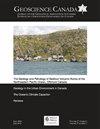Eugène Rodolphe Faribault: Nova Scotia Gold Icon
IF 1.8
4区 地球科学
Q3 GEOSCIENCES, MULTIDISCIPLINARY
引用次数: 0
Abstract
Eugène Rodolphe Faribault proved to be a very good choice as a geologist for the Geological Survey of Canada, after his appointment on July 1, 1883. His career spanned fifty years, time mostly committed to mapping the southwestern half of Nova Scotia, concentrated on the slate and quartzite of the Meguma Supergroup in which gold mining was taking place. In his words, he was, “a specialist on geological maps and structural geology of gold mines in Nova Scotia”. Dozens of his meticulously prepared maps of over sixty gold districts have stood the test of time for accuracy. A popular figure in the field, Faribault made frequent trips to operating mines. He early recognized the existence, in some districts, of extensive bodies of low-grade ore. He emphasized too, the similarities between the ‘saddle reef’ deposits mined in the Bendigo fields of Australia and the auriferous veins of the Meguma formations. His ‘pay-zone’ theory held that near-surface mineable ore in Nova Scotia gold mines should continue at depth, provided the same structural conditions persisted. However, for various reasons his theory received a mixed reception. Back in Ottawa at the GSC offices, Faribault was a highly respected figure among fellow workers and supervisors alike, and across all departments. His quiet charisma and friendly nature, complemented by professional expertise, won him accolades as an ambassador well beyond the workplace. For his excellence in a young developing science, Faribault thoroughly earned the epithet, “The Grand Old Man of Nova Scotian Geology”.欧仁-罗多尔夫-法里博:新斯科舍省黄金偶像
欧仁-鲁道夫-法里博(Eugène Rodolphe Faribault)于 1883 年 7 月 1 日被任命为加拿大地质调查局的地质学家,事实证明他是一个非常不错的选择。他的职业生涯长达五十年,大部分时间都在绘制新斯科舍省西南半部的地图,主要集中在开采金矿的 Meguma 超群的板岩和石英岩上。用他的话说,他是 "新斯科舍省金矿地质图和构造地质学方面的专家"。他精心绘制的六十多个金矿区的几十张地图的准确性经受住了时间的考验。法里博在该领域颇受欢迎,他经常前往正在开采的金矿。他很早就发现某些地区存在大量低品位矿体。他还强调了澳大利亚本迪戈矿区开采的 "鞍形礁 "矿床与Meguma地层的含金矿脉之间的相似性。他提出的 "付矿区 "理论认为,新斯科舍省金矿中的近地表可开采矿石应继续向深部延伸,前提是相同的构造条件持续存在。然而,由于种种原因,他的理论受到了褒贬不一的评价。 回到渥太华的金矿公司办公室后,法里博在同事和主管以及所有部门中都是一位备受尊敬的人物。他沉静的魅力和友善的性格,再加上专业的知识,为他赢得了工作场所以外的赞誉。由于他在一门年轻的发展中科学领域的卓越成就,法里博特彻底赢得了 "新斯科舍地质学老人 "的美誉。
本文章由计算机程序翻译,如有差异,请以英文原文为准。
求助全文
约1分钟内获得全文
求助全文
来源期刊

Geoscience Canada
地学-地球科学综合
CiteScore
3.30
自引率
0.00%
发文量
9
审稿时长
>12 weeks
期刊介绍:
Established in 1974, Geoscience Canada is the main technical publication of the Geological Association of Canada (GAC). We are a quarterly journal that emphasizes diversity of material, and also the presentation of informative technical articles that can be understood not only by specialist research workers, but by non-specialists in other branches of the Earth Sciences. We aim to be a journal that you want to read, and which will leave you better informed, rather than more confused.
文献相关原料
| 公司名称 | 产品信息 | 采购帮参考价格 |
|---|
 求助内容:
求助内容: 应助结果提醒方式:
应助结果提醒方式:


